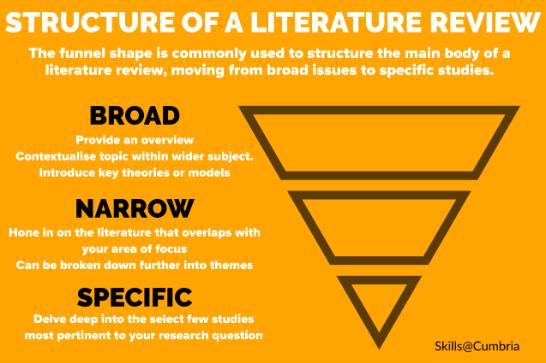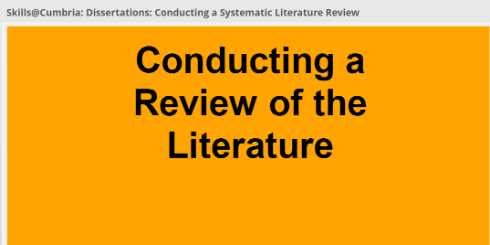| Carrying out your literature review - Download the Literature searching form to record your search process | |
|---|---|
| 1 |
Initially, you may read quite broadly round the subject area to further your understanding of the field. This should help you to focus in on your topic and establish the angle that your work will take. It should also help you identify your keywords, what are the term that are being used in the literature? Use a mindmap to record these possible keywords and any alternative spellings and synonyms. |
| 2 |
Once you have refined your topic and identified the relevant keywords for your search, you need to carry out a systematic search using Boolean, truncation and phrase searching. See Searching tips, use the Planning your search form and watch the Effective searching video.
In addition to the keyword searching above, you can also use the subject headings within the subject specific databases (not OneSearch) to search. A comprehensive search would combine a keyword search and a subject search. See the guide to Subject searching (in Ebsco resources). If you have been asked to use a PICO or other model see the section on health specific searching. |
| 3 |
Where to search? Every search engine works a little differently so you should carry out your search in a number of resources depending on your topic. OneSearch will give a wide general search but combine that with at least one subject specific database which will be more focused on your topic. See your Subject page for a list of suggested resources.
What type of information you need will vary with your research question so check out the Library resources to see the range of additional resources available, for example statistics, grey literature and dissertation collections. |
| 4 |
Record the process. You will need to record what you searched for and where, number of results and any limiters you used. This helps to demonstrate that you have identified the key research for your topic and is particularly important for stand alone literature reviews as this is your method. Save your searches within the databases and use the Literature searching form to record the process. You may not need all the numbers but at least you will know what you did when it comes to writing it up. |
| 4 |
Filter your results You may have many results. Sift and select your results using your inclusion/exclusion critieria -for example date, country, type of research. Use the filters within the databases. Check the abstracts to make sure they are relevant to your topic. |
| 5 |
Evaluate and appraise your sources. You may want to use a Critical reading grid for social science resources or a CASP tool for specific research types. This critical evaluation helps you to identify which are the key sources that you will discuss in more detail and which are the subsidiary sources that may support only one point. It will also identify key themes for you to discuss and identify any weakness in the sources.
|
| 6 |
Re-read your sources, synthesising them under themes, chronologically or theoretically depending on your research question. Use different coloured highlighters or post its on the wall, whatever works for you. Create a table using our Literature matrix of the relevant sources, summarising the key points for easy comparison. What have you learnt? Have you answered your question? |
Literature Review
There are two types of literature review that are similar but have different purposes:
- Part of a wider primary research project. It identifies what is currently known, sets the context of your research, identifies any gaps or areas for further development and situates you in the chain of research.
- A ‘stand-alone’ literature review is secondary research which uses published research to answer a question or explore a topic. It should include a new interpretation of the existing body of work: a synthesis of the information.
Either way a literature review is a select analysis of existing research which relates to your subject and the question(s) you have chosen. It’s not a summary of everything you can find which seems relevant but rather a critical review which identfies the key sources and analyses and interprets the findings. See the reading list for Literature reviews.
Take a look at this tutorial on how to conduct a Literature review and check out the resources in the sections below.
-
Carrying out your search
-
Specific resources for health students.
These are additional resources. Please also take a look at the Literature review tutorial and the other sections on Carrying out your search and writing it up.
PICO and other frameworks.
Health students are sometimes required to use a framework for their search question. There are a number of these and you can find out more on pages 4 and 5 of this NHS guide. These frameworks are to help you refine your question but can also help to structure your search.
PRISMA
You may be required to present your search results in a PRISMA. This is just a visual flow chart of your search process. It is more commonly used for full systematic reviews but can be a useful visualisation of the search process.
Take a look at our PRISMA tutorial and check out the resources on the PRISMA flow diagram page.
Critical appraisal
Use the the critical appraisal tools from CASP and The Centre for evidence based medicine to critique your sources.
The NHS has also created a Critical appraisal online course as part of the e-LfH. Register for free.
Also check out Rammona Naicker's checklist for critically appraising for anti-racism where she takes you through the biases in the way research is carried out and reported.
Scoping reviews
A scoping review is a way of mapping out the main ideas that inform a research topic.
At university, scoping reviews often form part of a bigger research project – for example, you may be asked to conduct a background literature review first, then justify your scoping review in the methodology. You will then carry out the scoping review itself, and engage in some discussion of the findings.
Have a look at our scoping review resource for more information.
-
Organising your sources and writing it up
How do you present what you have learnt? Synthesising your sources around key themes is the most common approach but there are several possible approaches depending on your subject area and topic:
- organised around key themes or debates
- from distant to close; from less specific to more specific
- a methodological approach, following the different methods used in your field
- a chronological approach, tracing the development.
Whichever you use it is often combined with a funnel approach, starting out broad and then becoming more specific. Think of it as an inverted triangle, or a filter funnel.
- First, briefly explain the broad issues related to your investigation; you don't need to write much about this, just demonstrate that you are aware of the breadth of your subject and context.
- Then narrow your focus to deal with the studies that overlap with your research
- Finally, hone in on any research which is directly related to your specific investigation. Proportionally you spend most time discussing those studies which have most direct relevance to your research.

Try using our FrameworkLiteratureReview.doc to organise your thoughts in a more critical way and see the Review dissertation structure for writing up a stand alone literature review.
See the skills@cumbria pages for Academic writing and Being critical.
For futher information this guidance from Reading may be helpful:
-
Search forms and other resources.

